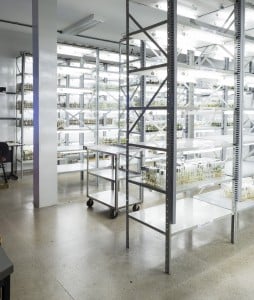State Of The Arts: Photographer Dornith Doherty Is Archiving Eden
ArtandSeek.net August 11, 2017 47Photographer Dornith Doherty spent nine years documenting remote seed vaults around the world — and the seeds inside them. She even got inside the so-called doomsday vault, in Norway, near the North Pole, designed to help preserve samples of botanical life in case of worldwide catastrophe.
Her large, ghostly images capture life inside seeds as small as a grain of sand. You can see them in her new book, “Archiving Eden,” and in the show by the same name at Amon Carter Museum of American Art.
For our weekly State of the Arts, I spoke Doherty about how she makes her ethereal work. Here are some excerpts from our conversation. Click above to listen to it.
On choosing the name “Archiving Eden”....It took me forever to come up with that title because I wanted something that would simultaneously capture the positive and negative aspects of seed banking and refer to the seed vault itself, which is the archive, but also the more poetic importance of plants for the world itself, which would be Eden
On why she was drawn to Svalbard Gobal Seed Vault in Norway... I was astounded to find out that someone had spent 30 years trying to build a fail-safe vault for the world’s botanical life near the north pole and it was simultaneously hopeful but also very very pessimistic. It was kind of this apocalyptic scenario in which they felt like they had to come up with a plan B in case things got very bad in the world.

Dornith Doherty
On the gravity of climate change in Norway… Listeners may have heard this spring that there was a flood inside the seed bank. The permafrost is starting to melt on this island [where Svalbard is located]. The fail-safe vault had a flood this spring. None of the seeds were damaged, but it does kind of point out how rapidly things are changing. [Svalbard is] built in a cavern that is deep inside the side of a mountain, on top of a mountain that is so tall that if both polar ice caps melt, the vault will be above the waterline. And it’s deep inside the permafrost to the point that if the electricity goes out, if the doors remain shut, the seeds will remain safe for 200 years or more.
So having this flood just shows that things are accelerating a little more quickly. And they’ve already published their plans to correct for the flooding, but it was a little bit unanticipated.

“Red Yucca” by Dornith Doherty
On using an X-ray machine for photos….That came right at the very beginning of the project. I was working at the United States seed bank and saw they had an X-ray machine that they were using for statistical analysis and research on seed viability and I was so intrigued with this notion of being able to look inside these tiny, tiny seeds -some are only the size of a grain of sand – and thinking about this spark of life that they were trying to preserve for centuries. So I asked if it would be possible for me to X-ray some of the seeds. I take those X-rays, capture them digitally and then go back to my studio here in Texas and create digital collages from them that kind of speak to some of the concerns I have about the sheer numbers that it takes to save a species or the very delicate seeds and their resilience in the face of time or draught. That line between resilience and delicacy underpinned a lot of the work.

“Pycnantha” by Dornith Doherty
On how scientists reacted to her work.…The scientists I work with are very enthusiastic about the project, especially the X-ray work. I think they find the metaphor and the visual poetry in that work connects very much with their sense of mission and the importance of what they do. Peering into the actual bodies of these plants they work with connects with ….I don’t want to call it the magic, but the power, the connectedness, of what they’re trying to do and how important it is.

“Incubator, EMBRAPA, Brasilia, Brazil,” by Dornith Doherty.
Doherty told me several fascinating stories about the sometimes random, sometimes heroic efforts that have gone into saving species of plant life. They were too long to put on the radio, but too good not to share. You can listen to them below.
Here, she shares how a family found a pouch of seeds in the attic that turned out to be
On how the Wollemi Pine, a prehistoric plant, was re-discovered in Australia.
The tragic and heroic story of a group of scientists who starved to death to protect a seed bank.

“Seeds Drying,” Lady Bird Johnson Wildflower Center, by Dornith Doherty.









